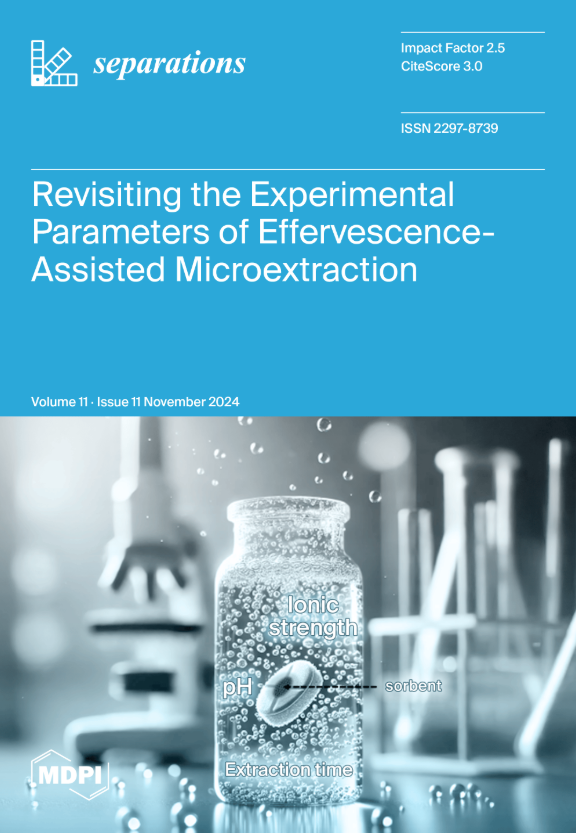Synthesis of Silica Gel Chelated with Alizarin and 1-Nitroso-2-Naphthol for Solid Phase Extraction of Lead in Ground Water Samples
IF 2.7
4区 工程技术
Q3 CHEMISTRY, ANALYTICAL
引用次数: 0
Abstract
Silica gel chemically functionalized with alizarin (Si-AZ) and 1-nitroso-2-naphthol (Si-NN) was synthesized and characterized by FT-IR, N2 adsorption-desorption, SEM, and elemental analysis. The two chelators show adequate sorption properties for Pb (II) and are hence used as SPE sorbents prior to their determination with ICP-MS. Both chelators showed high sorption efficiency for the Pb (II) ion at pH 8. Batch experiments demonstrate that the synthesized resins could remove more than 95% Pb (II) out of solutions containing 100 μg/mL of the ion. At optimum conditions, the maximum adsorption capacities for S-TDI-AZ and S-TDI-NN for Pb (II) were 9.56 and 9.43 mg/g, respectively. Method development was performed to investigate the applicability of the chelating resins as packing materials for SPE using model solutions and real groundwater samples. The method detection limits of SPE were 0.0025 and 0.0026 μg/L with high precision (R.S.D. < 3%). The recoveries of spiked Pb (II) with ground water were 104.70 and 102.62%. The proposed method was successfully applied to the determination of Pb (II) in the groundwater by ICP-MS.茜素- 1-亚硝基-2-萘酚螯合硅胶固相萃取地下水中铅的合成
合成了茜素(Si-AZ)和1-亚硝基-2-萘酚(Si-NN)化学功能化硅胶,并通过FT-IR、N2吸附-解吸、SEM和元素分析对其进行了表征。这两种螯合剂对Pb (II)表现出足够的吸附性能,因此在ICP-MS测定之前用作SPE吸附剂。两种螯合剂对pH为8的Pb (II)离子均表现出较高的吸附效率。批量实验表明,在含铅100 μg/mL的溶液中,合成的树脂对铅(II)的去除率达到95%以上。在最佳条件下,S-TDI-AZ和S-TDI-NN对Pb (II)的最大吸附量分别为9.56和9.43 mg/g。采用模型溶液和实际地下水样品,研究了螯合树脂作为固相萃取填料的适用性。该方法的SPE检出限分别为0.0025和0.0026 μg/L,精密度高(rsd <3%)。地下水加标Pb (II)的回收率分别为104.70%和102.62%。该方法成功地应用于ICP-MS法测定地下水中的铅(II)。
本文章由计算机程序翻译,如有差异,请以英文原文为准。
求助全文
约1分钟内获得全文
求助全文
来源期刊

Separations
Chemistry-Analytical Chemistry
CiteScore
3.00
自引率
15.40%
发文量
342
审稿时长
12 weeks
期刊介绍:
Separations (formerly Chromatography, ISSN 2227-9075, CODEN: CHROBV) provides an advanced forum for separation and purification science and technology in all areas of chemical, biological and physical science. It publishes reviews, regular research papers and communications. Our aim is to encourage scientists to publish their experimental and theoretical results in as much detail as possible. There is no restriction on the length of the papers. The full experimental details must be provided so that the results can be reproduced. There are, in addition, unique features of this journal:
Manuscripts regarding research proposals and research ideas will be particularly welcomed.
Electronic files and software regarding the full details of the calculation and experimental procedure, if unable to be published in a normal way, can be deposited as supplementary material.
Manuscripts concerning summaries and surveys on research cooperation and projects (that are funded by national governments) to give information for a broad field of users.
The scope of the journal includes but is not limited to:
Theory and methodology (theory of separation methods, sample preparation, instrumental and column developments, new separation methodologies, etc.)
Equipment and techniques, novel hyphenated analytical solutions (significantly extended by their combination with spectroscopic methods and in particular, mass spectrometry)
Novel analysis approaches and applications to solve analytical challenges which utilize chromatographic separations as a key step in the overall solution
Computational modelling of separations for the purpose of fundamental understanding and/or chromatographic optimization
 求助内容:
求助内容: 应助结果提醒方式:
应助结果提醒方式:


